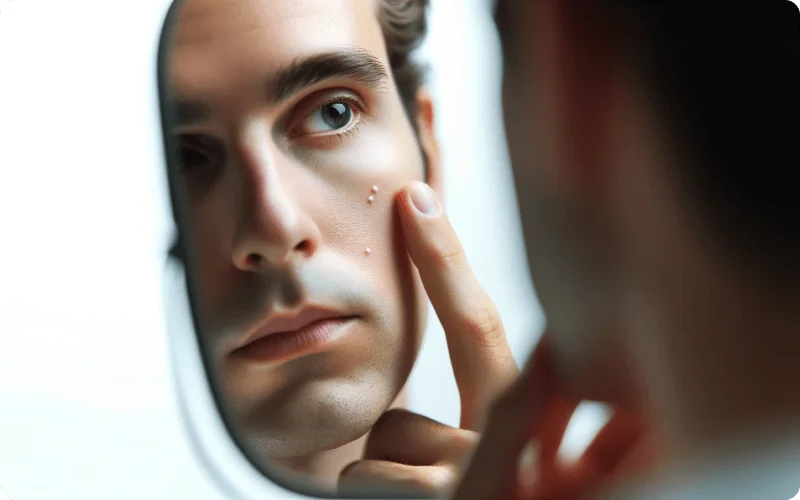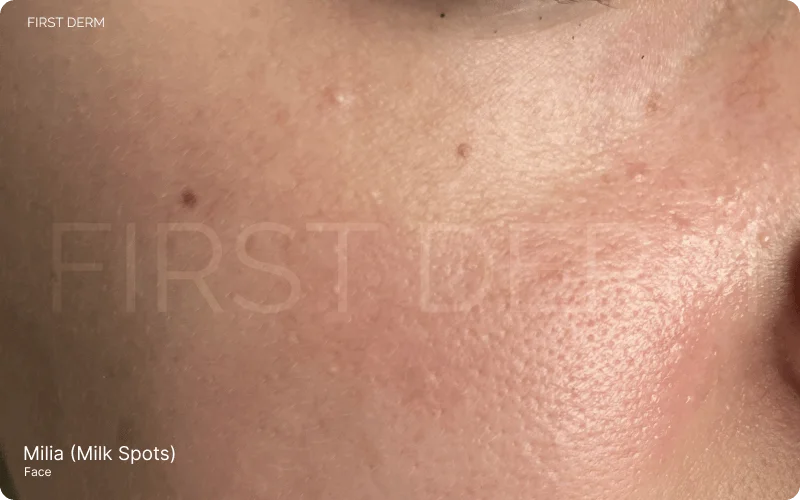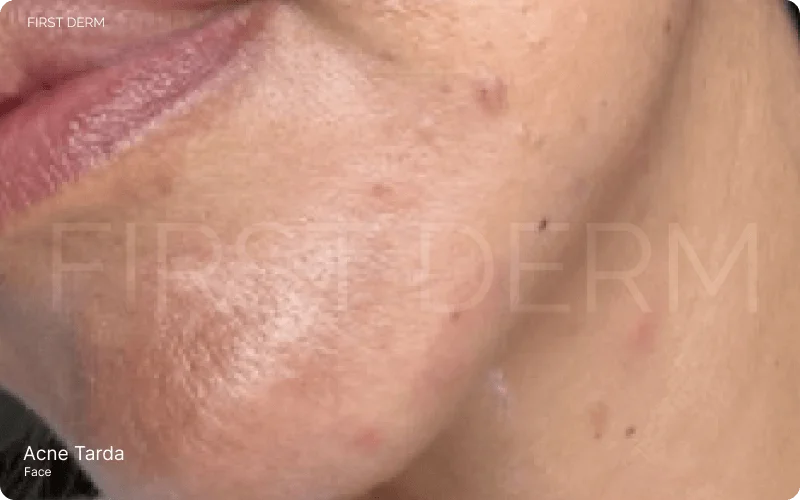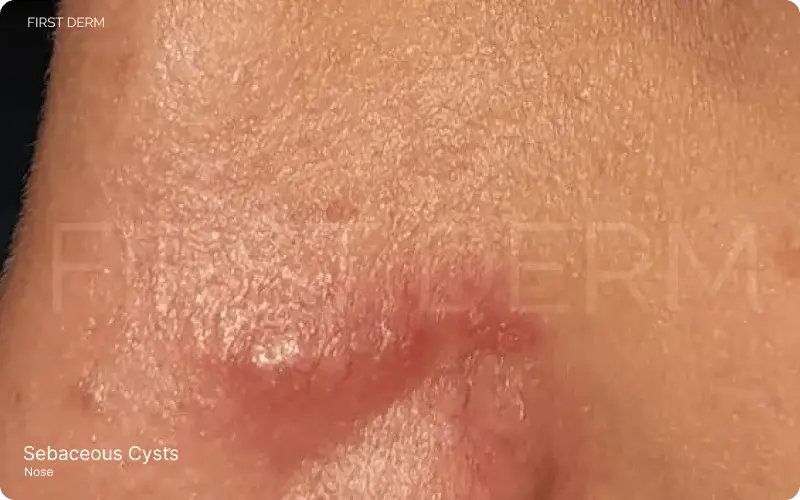White Bumps on the Face: Milia and Other Common Reasons

Discover the causes and characteristics of white facial bumps, from milia to sebaceous cysts, in this concise guide to common skin conditions.
White bumps on the face are a common occurrence, with causes ranging from sun exposure and aging to genetics and skin type. These bumps encompass various types, each with its own characteristics and potential treatments.
This article explores different types of white bumps, such as milia, clogged pores, sebaceous hyperplasia, sebaceous cysts, etc. along with their causes, diagnosis, treatment, and prevention tips.
Skin conditions that cause White Bumps on Face
1. Milia (Milk Spots)

Milia (milk spots), characterized by small white and tan bumps, prominently near the right side of the nose, surrounded by reddened and irritated skin.
Milia, also known as milk spots, are benign cysts that appear as small, firm, white bumps. These keratin-filled cysts typically manifest as discreet, pinhead-sized nodules.[1]
Their appearance is a consequence of keratin becoming trapped beneath the surface of the skin due to aberrations in the natural exfoliation process.These cysts are usually 1-2 mm in size and appear as dome-shaped bumps. They are most commonly found on the cheeks, eyelids,chin,and genital skin. Less frequently, milia may also manifest on the nose and forehead.[2]
Milia are typically not painful or itchy and are most common among infants, but they can affect people of all ages. They are harmless and usually only cause temporary cosmetic changes to the skin. Milia can be categorized as either primary or secondary. Primary milia are formed directly from entrapped keratin and are usually found on the face, while secondary milia develop after something clogs the ducts leading to the skin’s surface, such as after an injury, burn, or blistering.
Milia can also develop as a result of damage to the sweat glands after skin trauma or due to blocked sweat glands, especially in newborn babies. Cell turnover usually slows down as people get older, which can also contribute to the development of milia. Additionally, certain skin products, sun damage, and allergic reactions to facial products can also cause milia.
2. Clogged Pores (Comedones)

Acne Tarda on the face, characterized by white spots, concentrated around the chin with visible clogged pores and skin inflammation.
Clogged Pores, including whiteheads (closed comedones) and blackheads (open comedones), are common, mild forms of acne. They are formed by clogged pores that contain a buildup of excess bacteria, oil, and dead skin cells.
There are two main types of Clogged Pores: open comedones, also known as blackheads, and closed comedones, also known as whiteheads.[3]
- Open Clogged Pores (Blackheads): These are pores with a wider opening that are filled with excess oil and dead skin cells, which have undergone a chemical reaction resulting in the oxidation of melanin. This gives them the characteristic dark color
- Closed Clogged Pores (Whiteheads): These are pores with a much smaller opening than blackheads. The contents of the clogged pore are not exposed to the air, and they remain white or flesh-colored. They are formed by the buildup of excess bacteria, oil, and dead skin cells.
Clogged Pores are commonly found on the face, particularly on the forehead, nose, and chin. They can also occur on the chest, back, and shoulders. They are usually noninflammatory and are considered the first stage of acne.
To prevent and treat clogged pores, it’s important to maintain a good skincare routine, including regular cleansing and exfoliation. Additionally, using non-comedogenic (non-pore-clogging) skincare products can help prevent the formation of comedones.[4]
3. Sebaceous Hyperplasia

Sebaceous Hyperplasia, featuring a distinct white bump on the cheek, caused by an enlarged sebaceous gland with trapped sebum.
Sebaceous hyperplasia is a benign condition characterized by small, yellowish bumps, typically up to 3 mm in diameter, with a central hair follicle surrounded by yellowish lobules and prominent blood vessels.[5]
These bumps are commonly found on the forehead or cheeks and are a result of enlarged sebaceous glands. They can be mistaken for basal cell carcinoma, but a key feature that differentiates sebaceous hyperplasia from basal cell carcinoma is the ability to express sebum from the central depression.
Distinguishing Features: Differentiation from Basal Cell Carcinoma
- Ability to Express Sebum: A central depression in the bump can express sebum, a key feature distinguishing it from basal cell carcinoma.
- Visual Characteristics: The bumps are small, shiny, with a central hair follicle and yellowish lobules.
Medical Evaluation
- Diagnosis: A healthcare provider can often diagnose sebaceous hyperplasia with a visual inspection.
- Further Testing: In cases of uncertainty, a skin biopsy may be conducted to exclude conditions like skin cancer.
The condition is generally harmless and doesn’t require treatment unless the bumps are bothersome.
4. Sebaceous Cysts

An inflamed sebaceous cyst on the nose, marked by significant redness and swelling, illustrating the typical symptoms of this skin condition
Sebaceous cysts are small, benign lumps that form under the skin. They are typically slow-growing and filled with keratin material, a protein that is produced by the skin.
Appearance
Sebaceous cysts can occur anywhere on the body, but they are most found on the face, neck, upper back, and upper chest.
They can range in size from a few millimeters to several centimeters and are often painless.
Common Causes
- Blocked sebaceous gland.
- Ruptured follicle, often related to acne.
- Injury to the area.
Sometimes they appear without a clear cause.
Diagnosis, Treatment and Management
Sebaceous cysts can be diagnosed with a physical examination and medical history. Most cysts don’t cause problems or need treatment, but if a cyst is bothering you for any reason, see your healthcare provider.
References
- Milium, milia | DermNet. Dermnetnz.org. Published 2022. Accessed December 30, 2023. https://dermnetnz.org/topics/milium
- Gallardo Avila PP, Mendez MD. Milia. In: StatPearls [Internet]. Treasure Island (FL): StatPearls Publishing; 2023. Updated 2023 Jan 31. Available from: https://www.ncbi.nlm.nih.gov/books/NBK560481/
- InformedHealth.org [Internet]. Cologne, Germany: Institute for Quality and Efficiency in Health Care (IQWiG); 2006-. Acne: Overview. 2013 Jan 16 [Updated 2019 Sep 26]. Available from: https://www.ncbi.nlm.nih.gov/books/NBK279211/.
- Sutaria AH, Masood S, Saleh HM, et al. Acne Vulgaris. In: StatPearls [Internet]. Treasure Island (FL): StatPearls Publishing; 2023. Updated 2023 Aug 17. Available from: https://www.ncbi.nlm.nih.gov/books/NBK459173/.
Ask a Dermatologist
Anonymous, fast and secure!

Dr. Raquel Molina Martinez is a board-certified dermatologist from Barcelona with over a decade of experience. Trained at Gothenburg’s University Hospital, she now practices at Centre Medic in Catalonia.

